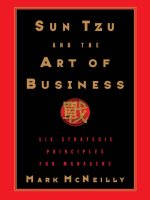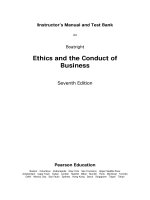Ethics and the conduct of business 8th by john boatright and smith 2017 chapter 2
Bạn đang xem bản rút gọn của tài liệu. Xem và tải ngay bản đầy đủ của tài liệu tại đây (265.83 KB, 17 trang )
Ethics and the Conduct of Business
Eighth edition
Chapter 2
Ethical Decision
Making
Copyright © 2017, 2012, 2009 Pearson Education, Inc. All Rights Reserved
Modules
• Introduction: Ethical Decision Making
• 2.1: Market Ethics
• 2.2: Roles, Relationships, and Firms
• 2.3: Ethical Reasoning
• Conclusion: Ethical Decision Making
Copyright © 2017, 2012, 2009 Pearson Education, Inc. All Rights Reserved
Learning Objectives
•
•
•
2.1: Recognize the features of the market system, the ethic
s of market transactions, and the problems created by imper
fect market conditions
2.2: Identify the duties and obligations associated with fun
damental business roles and relationships in markets and fir
ms
2.3: Describe the philosophical and psychological approache
s to ethical reasoning and the principles that constitute a
moral framework for business conduct
Copyright © 2017, 2012, 2009 Pearson Education, Inc. All Rights Reserved
Introduction: Ethical Decision Making
• A buyer and seller come together to trade
• Business activity involves roles and relationships
• Seven basic principles of ethical decision making
Copyright © 2017, 2012, 2009 Pearson Education, Inc. All Rights Reserved
2.1: Market Ethics (1 of 4)
Objective: Recognize the features of the market system, the ethics of market transactions,
and the problems created by imperfect market conditions
• 2.1.1: The Market System
– Features
– Justification
– Market outcomes
• 2.1.2: Ethics in Markets
– Self-interest
– Morally free zone
– Ethics for imperfect markets
Copyright © 2017, 2012, 2009 Pearson Education, Inc. All Rights Reserved
2.1: Market Ethics (2 of 4)
Objective: Recognize the features of the market system, the ethics of market transactions,
and the problems created by imperfect market conditions
• 2.1.3: Breaches and Fraud
–
–
–
–
Implicit
Incomplete
Lack remedies
Fraud and manipulation
• 2.1.4: Wrongful Harm
– Obligations of morality
– Due care and negligence
Copyright © 2017, 2012, 2009 Pearson Education, Inc. All Rights Reserved
2.1: Market Ethics (3 of 4)
Objective: Recognize the features of the market system, the ethics of market transactions,
and the problems created by imperfect market conditions
• 2.1.5: Market Failure
–
–
–
–
Conditions
Externalities
Public goods
Collective choice
Copyright © 2017, 2012, 2009 Pearson Education, Inc. All Rights Reserved
Figure 2.1: Prisoner’s dilemma
Copyright © 2017, 2012, 2009 Pearson Education, Inc. All Rights Reserved
2.1: Market Ethics (4 of 4)
Objective: Recognize the features of the market system, the ethics of market transactions,
and the problems created by imperfect market conditions
• 2.1.6: Summary of Market Ethics
– To address problems in imperfect markets
– Laws
Copyright © 2017, 2012, 2009 Pearson Education, Inc. All Rights Reserved
Table 2.1: Ethics in Markets
Problems
Elements
Solutions
Violation of agreements
(breaches of contract)
Breaches of contract often result from
agreements that are implicit,
incomplete, and lack immediate
remedy.
• Contract law
• Principles for promise keeping
Misrepresentation of
information (fraud)
Fraud involves not only
misrepresentation of information but
also materiality, intent to deceive,
reliance, and harm.
• Anti-fraud law
• Principles for honesty
Wrongful harm of others
(torts)
Torts are the intentional or negligent
violation of rights in such matters as
health, safety, privacy, property, and
discrimination.
• Tort law
• Principles for due care
Market failures
(inefficiency)
Market failures result in inefficiency
due to low competition, externalities,
public goods, and collective choice
problems.
• Government regulation and
legislation like antitrust law,
consumer law, employment law,
securities law, environmental law,
taxation
• Special use of market Mechanisms
• Trustworthy behavior
Copyright © 2017, 2012, 2009 Pearson Education, Inc. All Rights Reserved
2.2: Roles, Relationships, and Firms (1
of 2)
Objective: Identify the duties and obligations associated with fundamental business roles
and relationships in markets and firms
• 2.2.1: Agents and Principals
– Agents
– Duties of agents
• 2.2.2: Fiduciaries and Professionals
–
–
–
–
–
Fiduciary
Fiduciary duty
Fiduciary relationship
Defining features of profession
Standard of profession
Copyright © 2017, 2012, 2009 Pearson Education, Inc. All Rights Reserved
2.2: Roles, Relationships, and Firms (2
of 2)
Objective: Identify the duties and obligations associated with fundamental business roles
and relationships in markets and firms
• 2.2.3: Firms
– Economic view
– Legal view
– Sociological view
• 2.2.4: Summary of Roles, Relationships, and
Firms
– Divided into two ethics
– Obligations
– Myriad roles and relationships
Copyright © 2017, 2012, 2009 Pearson Education, Inc. All Rights Reserved
2.3: Ethical Reasoning (1 of 2)
Objective: Describe the philosophical and psychological approaches to ethical reasoning
and the principles that constitute a moral framework for business conduct
• 2.3.1: Philosophical Accounts
– Moral point view
– Features of moral point view
• 2.3.2: Psychological Accounts
– Psychologist’s conclusion
– Daniel Kahneman’s perspective
– Lawrence Kohlberg’s perspective
Copyright © 2017, 2012, 2009 Pearson Education, Inc. All Rights Reserved
Table 2.2: Moral Development According
to Kohlberg
Level
Pre-Conventional Morality
Stages
1. Obedience and Punishment
Orientation
Ethical Reasoning
People are focused on themselves
and incapable of other-oriented
ethical reasoning or behavior.
2. Self-Interest Orientation
Conventional Morality
3. Good Interpersonal Relations
4. Authority and Social Order
Orientation
People* are mindful of others,
understand rules and laws, and
conform to societal expectations.
*Most adults
Post-Conventional Morality
5. Social Contract and Individual
Rights Orientation
6. Universal Principle Orientation
People* can engage in mutually
advantageous cooperation,
understand the value of abstract
moral principles, and practice
sophisticated ethical reasoning.
*Fewer than 20% of adults
Copyright © 2017, 2012, 2009 Pearson Education, Inc. All Rights Reserved
2.3: Ethical Reasoning (2 of 2)
Objective: Describe the philosophical and psychological approaches to ethical reasoning
and the principles that constitute a moral framework for business conduct
• 2.3.3: Framework for Reasoning
– Awareness of issues
– Identifying issues
– Resolving issues
Copyright © 2017, 2012, 2009 Pearson Education, Inc. All Rights Reserved
Figure 2.2: Candor, Care, Loyalty
Copyright © 2017, 2012, 2009 Pearson Education, Inc. All Rights Reserved
Conclusion: Ethical Decision Making
• Two parts of business ethics
• Roles and relationships
Copyright © 2017, 2012, 2009 Pearson Education, Inc. All Rights Reserved









